So there I was, staring at my 450-square-foot studio apartment last March, laptop balanced on my kitchen counter, back screaming from hunching over for three hours straight. Working from home had become permanent, but my “office” situation was anything but sustainable. Sound familiar?
I’ve spent the last ten months (and way too much money on returns) figuring out how to create a functional workspace in spaces that weren’t designed for it. Here’s what actually works – and what definitely doesn’t.
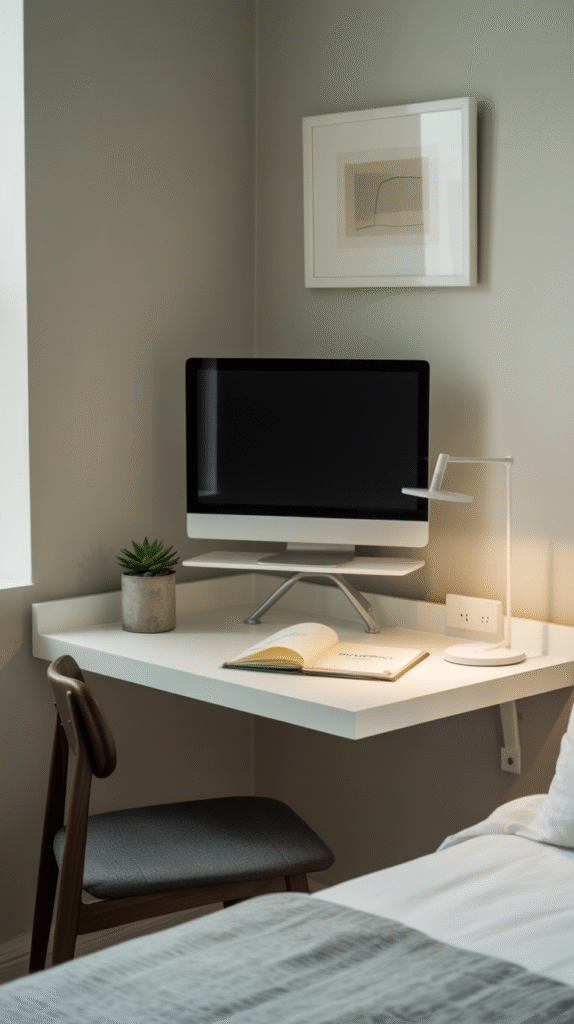
The Corner That Changed Everything
My first breakthrough came when I stopped thinking about needing a whole room. I had this awkward corner in my bedroom that I’d been using as a dumping ground for clean laundry. One weekend, I measured it out – barely 4 feet by 3 feet – and thought, “What if?”
I found this floating corner desk on Wayfair for $120 that fits perfectly into 90-degree angles. The genius part? It doesn’t touch the floor, so the space underneath still feels open. I paired it with a wall-mounted monitor arm, and suddenly I had a legitimate workspace that didn’t eat up my entire room.
Pro tip: Before buying any corner desk, measure both walls AND the diagonal space. I learned this the hard way when my first choice wouldn’t fit because of the baseboards.
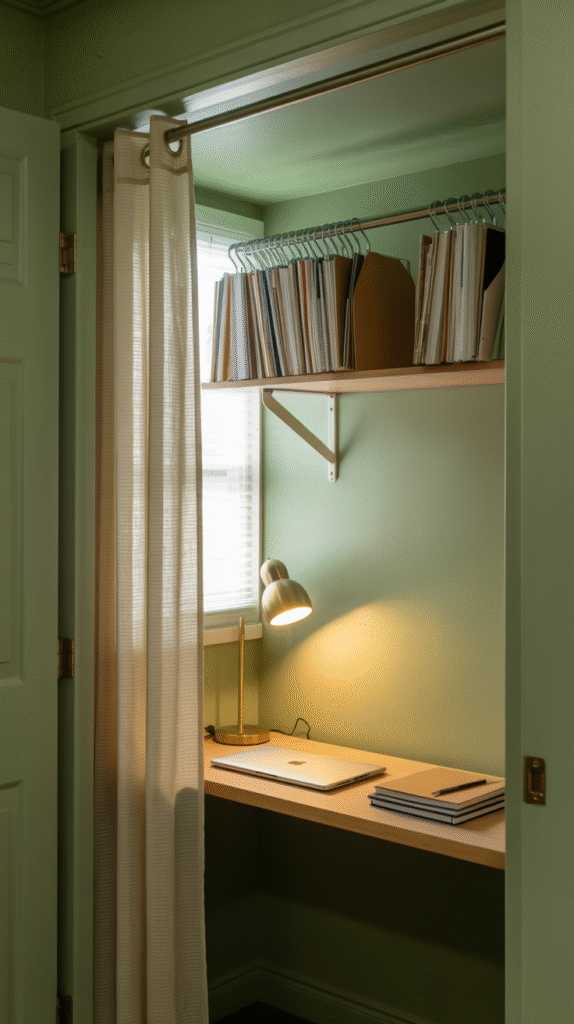
The Closet Office Revolution
My friend Sarah turned her hall closet into the most Instagram-worthy office I’ve ever seen. She removed the doors, added a floating shelf at the perfect height (29 inches for her), and installed a tension rod above for hanging file folders. The whole project took one weekend and cost under $200.
The key was painting the inside a light, energizing color. She went with this soft sage green that makes the tiny space feel bigger and more intentional. When she’s done working, she just pulls a pretty curtain across the opening.
What I love about this setup is that it’s completely separate from her living space. No more laptop on the coffee table or papers scattered across the dining room.
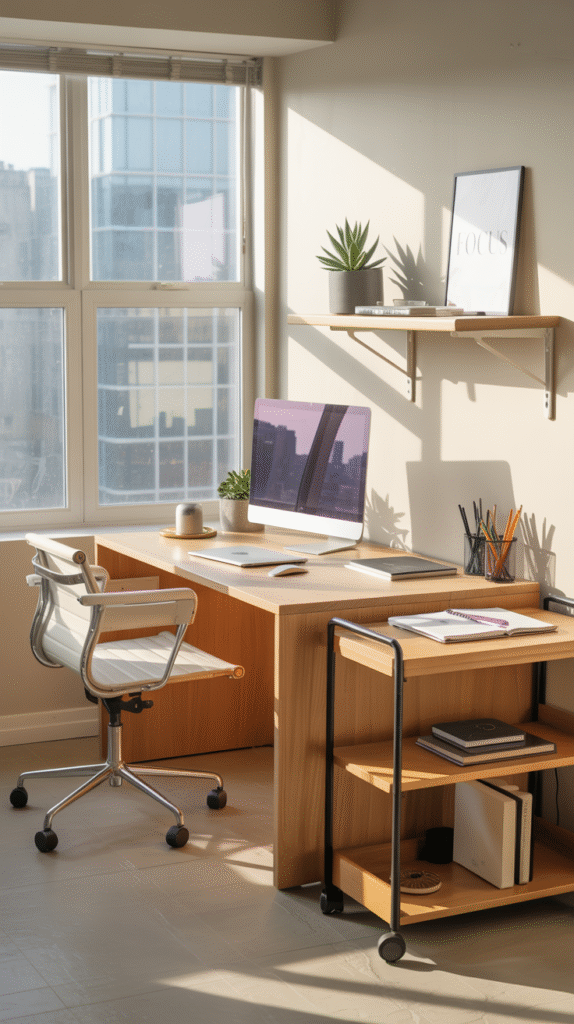
Multi-Level Magic
This one’s been a game-changer for my productivity. I created different work zones at different heights using a combination of my desk, a rolling cart, and a wall-mounted shelf system.
My computer lives on the main desk surface, but I have a standing-height shelf (42 inches) mounted above for when I need to switch positions. The rolling cart becomes my “meeting table” – I can pull it close for video calls or push it aside when I need more legroom.
The secret sauce? Everything has a designated spot, so transitioning between tasks doesn’t involve shuffling papers around.
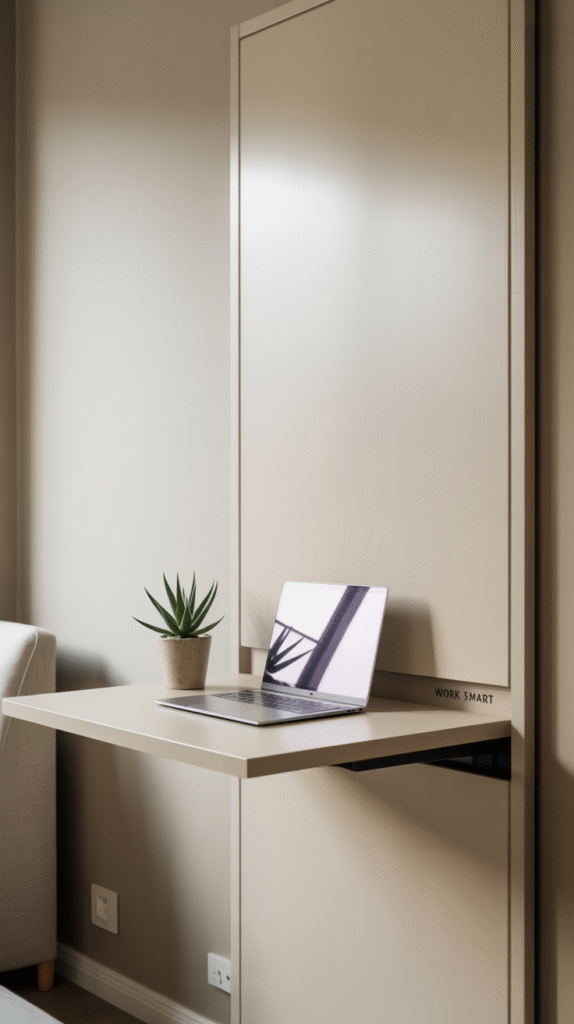
The Fold-Away Solution
If you’re dealing with a truly tiny space, I can’t recommend fold-down desks enough. I installed one in my cousin’s 300-square-foot apartment last summer, and it’s been a revelation.
When she’s working, it’s a proper 24-inch deep workspace. When she’s done, it folds completely flat against the wall and looks like modern art. The model we chose (from CB2, around $300) even has built-in cord management, so there are no dangling wires when it’s closed.
The trick is mounting it at the right height. We measured her seated elbow height and subtracted 2 inches – ended up being 26 inches from the floor, which is perfect for her.
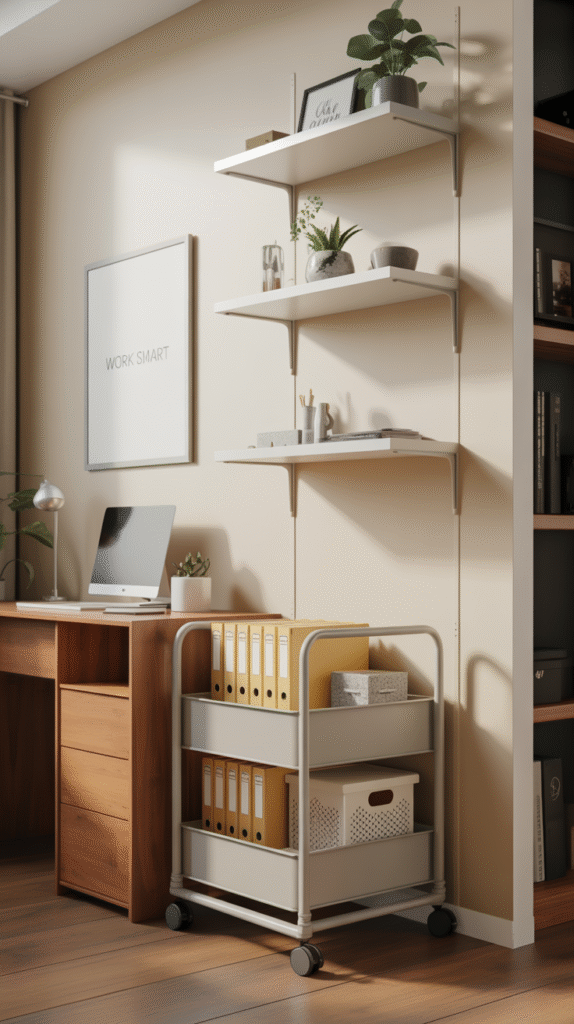
Storage That Actually Works
I used to think I needed a massive filing cabinet, but that’s just not realistic in a small space. Instead, I’ve gotten creative with vertical storage that doesn’t overwhelm the room.
My favorite discovery? These slim rolling carts that fit in the 6-inch gap between my desk and the wall. I have one for office supplies, one for files, and one that’s basically a mobile coffee station. When I need something, I just pull the cart out.
For books and binders, I mounted floating shelves at different depths – 6 inches for paperbacks, 10 inches for binders. It creates visual interest and maximizes storage without the bulk of a bookshelf.
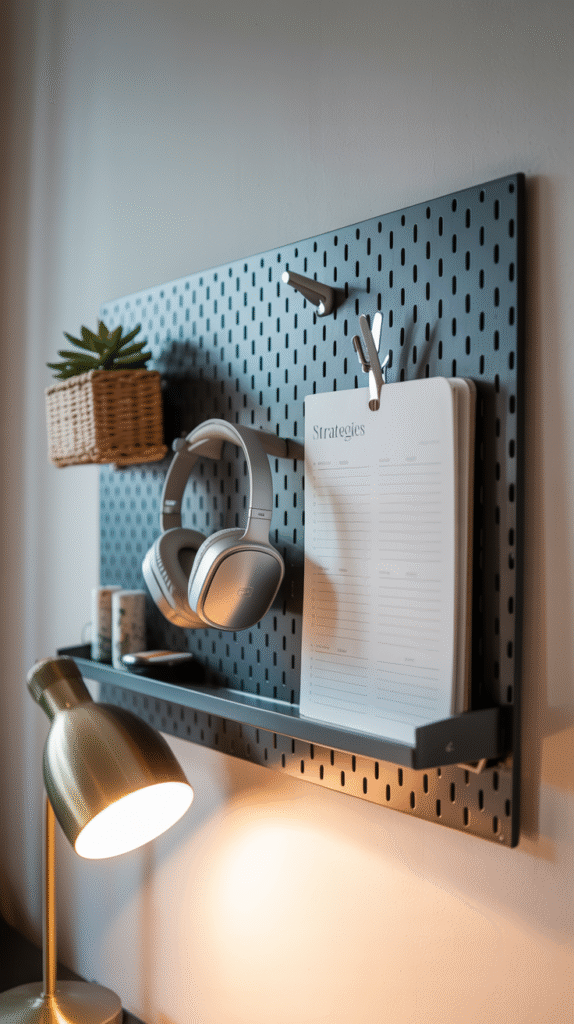
The Pegboard Game-Changer
Last fall, I finally bit the bullet and installed a pegboard above my desk. Best decision ever. It’s like having a command center where everything is visible and accessible.
I painted mine the same color as my wall (a soft charcoal gray) so it feels intentional rather than industrial. The key is curating what goes on it – I rotate supplies seasonally and only keep daily essentials visible.
The hooks and baskets are surprisingly sturdy too. I have my wireless headphones, a small plant, my daily planner, and even a lightweight desk lamp hanging from it.
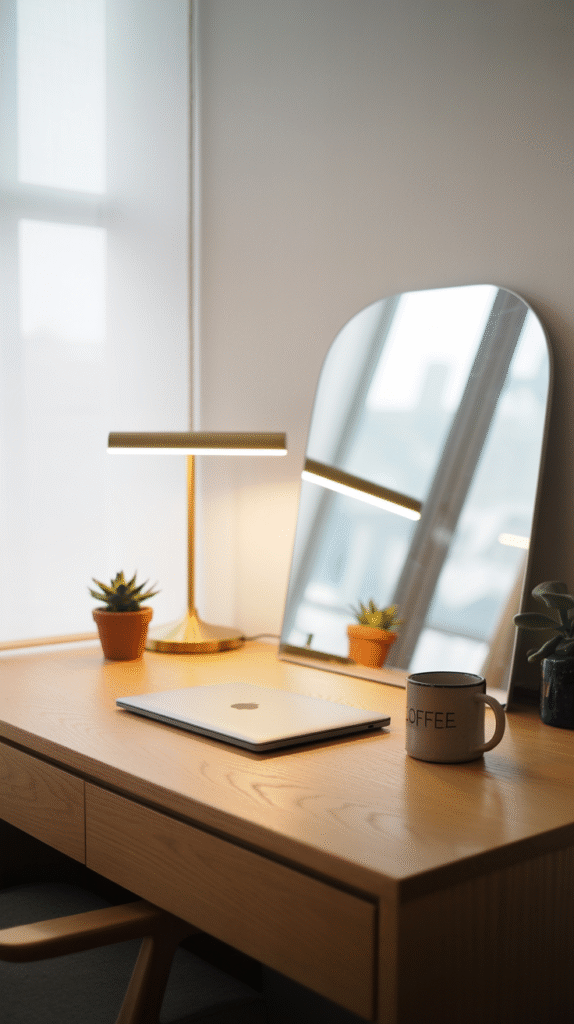
Natural Light Tricks
Working in a space with limited natural light was killing my mood until I figured out how to maximize what I had. I moved my desk perpendicular to the window instead of facing it – this cuts down on screen glare but still gives me that crucial side lighting.
I also added a small mirror on the opposite wall, which bounces light around the space and makes it feel less cave-like. It’s one of those convex mirrors from Target ($25) that adds a bit of personality too.
For evening work, I have three different light sources: a desk lamp for task lighting, a small table lamp for ambient light, and LED strips behind my monitor to reduce eye strain.

The Rolling Office Cart
This might be my most practical discovery. I found this three-tier rolling cart at IKEA for $40 and turned it into a mobile office station. Top shelf: laptop and mouse pad. Middle shelf: notebook and pens. Bottom shelf: chargers and cables.
When I’m working, I roll it next to my dining table or couch. When I’m done, it goes in the corner or even into the closet. It’s been perfect for my nomadic work style, and guests never feel like they’re eating dinner in my office.
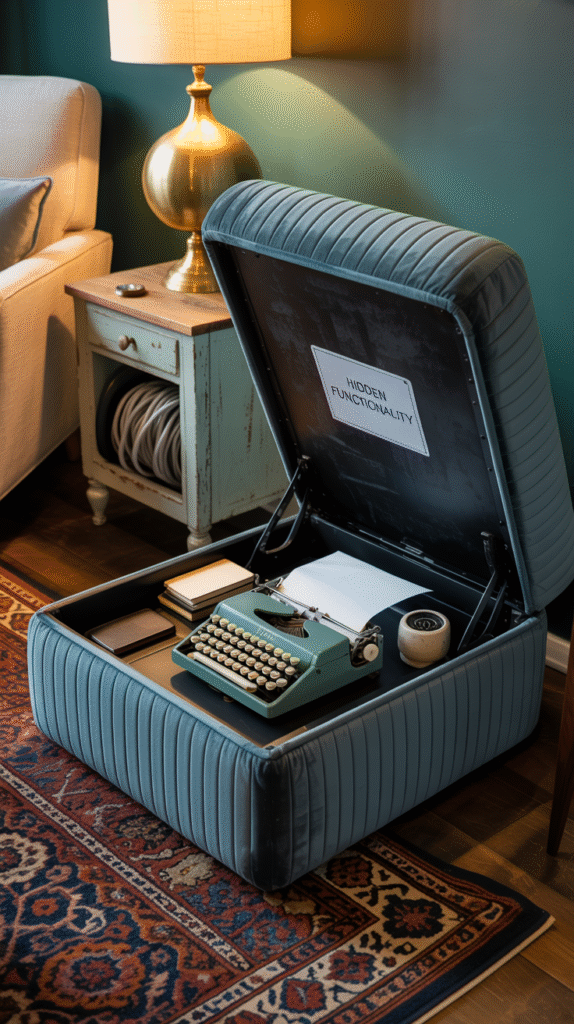
Dual-Purpose Furniture Solutions
My ottoman isn’t just for putting my feet up – it opens to reveal all my office supplies. My side table has a hidden drawer for cables and chargers. Even my desk chair doubles as extra seating when friends come over.
The key is choosing pieces that look like regular furniture first, storage second. I’ve found that vintage-style pieces often have the best hidden compartments, and they add character to the space.
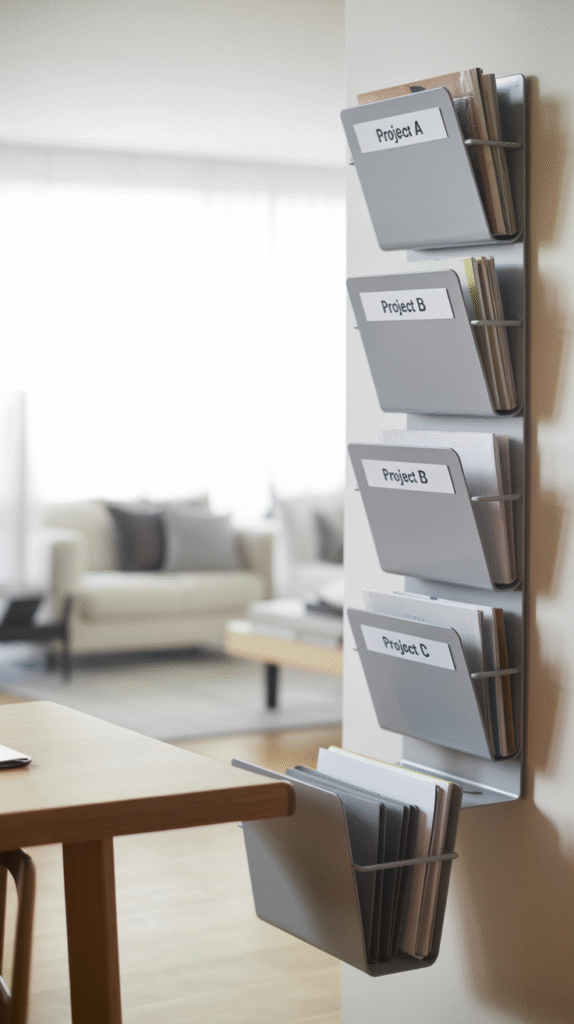
The Vertical File System
Traditional filing cabinets are space hogs, so I went vertical. I mounted a series of magazine holders on the wall next to my desk, each labeled for different projects. It’s way more visual than a drawer system, and I actually use it because everything’s right there.
For important documents, I have a single hanging file folder that slides into the top drawer of my desk. It holds maybe 20 files, but honestly, that’s all I need in the digital age.

Cable Management That Actually Looks Good
Nothing ruins a clean workspace like a tangle of cables. I’ve tried every organizer out there, and here’s what actually works in small spaces:
First, I mounted a power strip under my desk and plugged everything into that. Then I used these fabric cable sleeves to group cords by function – all computer cables in one sleeve, all charging cables in another.
The secret weapon? 3M Command strips with cable clips. I can route cables along walls and furniture edges without drilling holes or creating permanent changes.
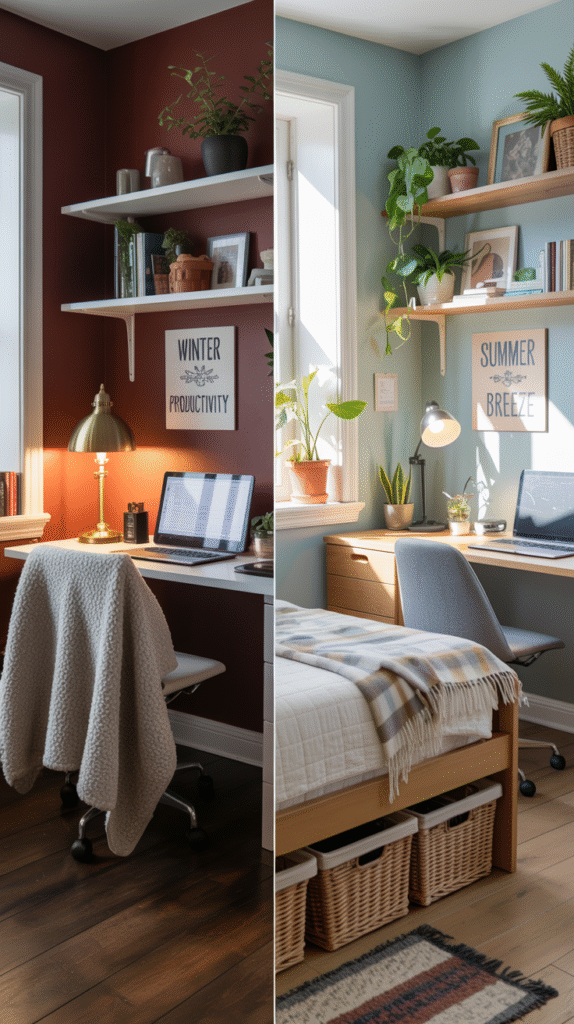
The Seasonal Rotation System
This one’s crucial for small spaces – I don’t keep everything out all the time. I have a “winter office” setup with warmer lighting and cozy textures, and a “summer office” with lighter colors and better airflow.
Storage bins under my bed hold the off-season items. It takes maybe 30 minutes to switch everything over, but it keeps my small space from feeling cluttered and gives me something to look forward to.
Making It Feel Like Home
The biggest mistake I made initially was treating my workspace like a separate, sterile zone. Now I make sure it feels connected to the rest of my home. I use the same color palette, include personal photos, and always have a plant or two.
A small diffuser with different scents for different types of work. Peppermint for morning emails, lavender for afternoon creative work. It sounds silly, but it really helps me transition into work mode, even in a shared space.
The truth is, creating a functional office in a small space isn’t about having the perfect setup – it’s about finding what works for your specific situation and being willing to experiment. Some of my best solutions came from mistakes or happy accidents.
Start with one corner, one wall, or even one cart. You don’t need to transform your entire space overnight. Sometimes the smallest changes make the biggest difference in how you feel about your workspace.
